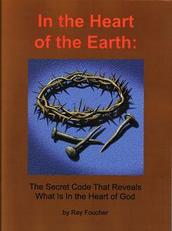Nisan 14 was on Thursday
(Part 2 of 3-part Study)
Thursday, Nisan 14, as explained in chapter four of the book
In the Heart of the Earth: The Secret Code That Reveals What Is In the Heart of God
was regarded by Jesus as Passover, the day when the lamb was to be killed and the Passover meal prepared:
"Then came the day of unleavened bread, when the passover must be killed. And he sent Peter and John, saying, Go and prepare us the passover, that we may eat." (Luke 22:7-8)
This page is part-2 of a 3-part study on the timing of
the crucifixion (part-1)
commonly understood to have been on Nisan 14, in relation to the timing of the triumphal entry into Jerusalem commonly understood to have been on Sunday, Nisan 10.
Jesus could see that He was being rejected and went ahead with arrangements to share the Passover meal with His close friends. Then "... when the even was come ..." (Matt 26:17) they partook of the meal. This was in the early evening hours of Nisan 15, the first day of the Feast of Unleavened Bread. While just a few hours after the sacrifice made on the afternoon of Nisan 14, technically it was the next day as a new day begins at sunset. At that meal, He introduced key symbols related to Passover that would be fulfilled in Him: "... this is my body ..." (1 Cor 11:24); "... this is my blood ..." (Mark 14:24) and He asked His followers to "... do this in remembrance of me." (1 Cor 11:24)
Later that evening, He was taken prisoner. He was further tested in a series of trials and, even though He was without fault, He was condemned and crucified. Although Jesus' death on Nisan 15 would seem to be a day late, it was the day, because of sectarian differences between liberals and conservatives, when most of the population of Israel expected the Passover lamb to be slain and more people would then recognize Him as the true Passover Lamb.
An interesting note here is that the earthly sanctuary was but a representation of the sanctuary in heaven where Jesus is spoken of as:
"... an high priest, who is set on the right hand of the throne of the Majesty in the heavens; A minister of the sanctuary, and of the true tabernacle, which the Lord pitched, and not man." (Heb 8:1-2)
Everything in the earthly sanctuary was symbolic of its greater counterpart in the heavenly sanctuary:
"For Christ is not entered into the holy places made with hands, which are the figures of the true; but into heaven itself, now to appear in the presence of God for us:" (Heb 9:24)
Here is an interesting question that you have probably never thought of:
Where was the equivalent of the earthly altar of sacrifice in the heavenly sanctuary?
The altar was where, for centuries, sacrifices were offered, all pointing forward to the true Lamb of God. The answer to the question above is that, since the sacrifice of the heavenly system (which is on a much greater scale than its earthly representation) was Jesus, the altar of the heavenly sanctuary was actually the cross of Calvary on earth. It should have been the altar of sacrifice in the temple - the same site where Abraham "offered" his son Isaac.
If the earthly sanctuary is modeled after the heavenly sanctuary, why would the timing of events on earth not follow that of the heavenly system (including a Nisan 14 crucifixion)? The answer is related to the topic of
God and free will in part-3
of this study.
|




New! Comments
Have your say about what you just read! Please leave a comment below.